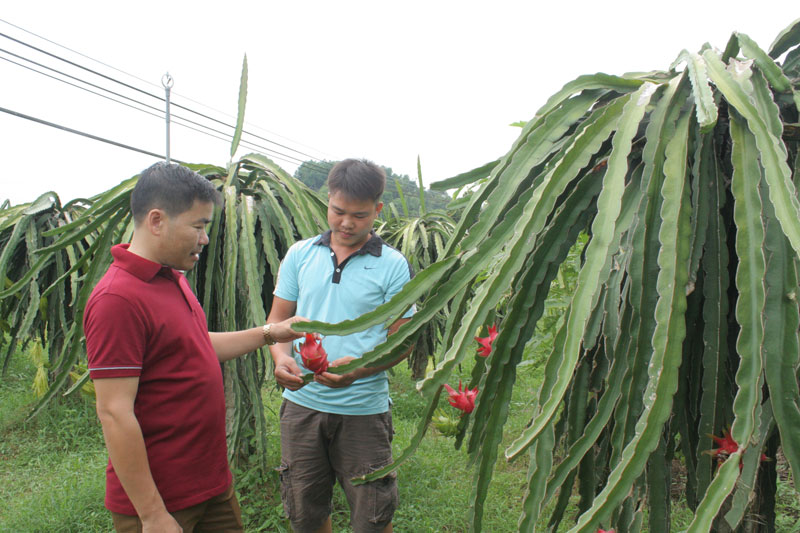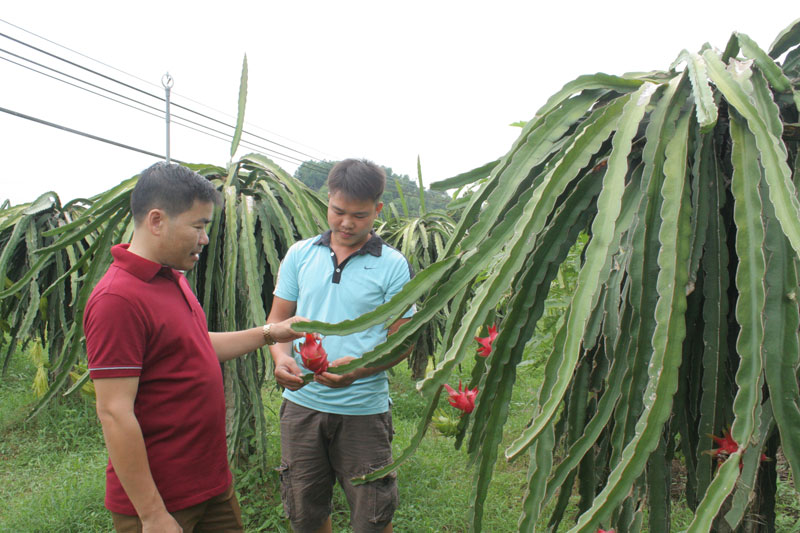
(HBO) – Everyone in Dong Bac commune knows Secretary of the local Party committee Bui Van Binh. Binh, born in 1962, is the first one who succeeded in growing dragon fruit in the commune.

Leaders of the Dong Bac People’s Committee visit Binh’s dragon
fruit farm.
Binh said his
family owns over 3,000 square metres of land. Earlier, his family grew rice,
but the water shortage forced them to switch to sugarcane and corn. However, the
cultivation brought unstable income.
In 2015, Binh
heard in the media about a farming model in Suoi Soi, Lac Thuy district
invested by Tran Hung from Hanoi. The model combined the cultivation of flower
and dragon fruit with tourism. He then came to the site to learn more about the
model and brought home dragon saplings in Lac Thuy.
"At first, I tested
cultivating both white- and red-flesh dragon fruits on 2,000 square metres. They
grew well and, in 2016, I planted 420 more saplings on more than 1,000 square
metres.”
Talking about
difficulties in their early days planting dragon fruit, Binh’s wife Bui Thi
Chau said: With support from relatives and friends, he built 420 concrete
columns along with an irrigation system using water from drilled well. Our
efforts have paid off, when the plants produced the first fruits in 2016. That
year we earned 30 million VND. In 2017, my family harvested about 4-5 tonnes of
fruit, gaining 70 million VND. This year is our third year of harvesting dragon
fruit, with the average selling price reaching 20-25,000 VND per kg and revenue
estimated at over VND100 million./.
According to data from the Hoa Binh Provincial Party Committee, the industrial production index for the first six months of 2025 is estimated to have increased by 20% compared to the same period last year. This marks the highest year-on-year growth rate for this period since 2020.
In the first six months of 2025, Hoa Binh province’s export turnover was estimated at 1.145 billion USD, marking an 18.11% increase compared to the same period in 2024. Import turnover was estimated at $ 804 million, a 17.15% increase, which helped the province maintain a positive trade balance.
The lives of the ethnic minority farmers in Tan Lac district have gradually improved thanks to the new directions in agricultural production. This is a testament to the collective strength fostered through the professional associations and groups implemented by various levels of the district’s Farmers’ Union.
With the motto the "product quality comes first,” after nearly one year of establishment and operation, Muong village’s Clean Food Agricultural and Commercial Cooperative, located in Cau Hamlet, Hung Son Commune (Kim Boi district), has launched reputable, high-quality agricultural products to the market that are well-received by consumers. The products such as Muong village’s pork sausage, salt-cured chicken, and salt-cured pork hocks have gradually carved out a place in the market and they are on the path to obtaining the OCOP certification.
In the past, the phrase "bumper harvest, rock-bottom prices" was a familiar refrain for Vietnamese farmers engaged in fragmented, small-scale agriculture. But today, a new spirit is emerging across rural areas of Hoa Binh province - one of collaboration, organisation, and collective economic models that provide a stable foundation for production.
Maintaining growing area codes and packing facility codes in accordance with regulations is a mandatory requirement for agricultural products to be eligible for export. Recently, the Department of Agriculture and Environment of Hoa Binh province has intensified technical supervision of designated farming areas and packing facilities to safeguard the "green passport" that enables its products to access international markets.



